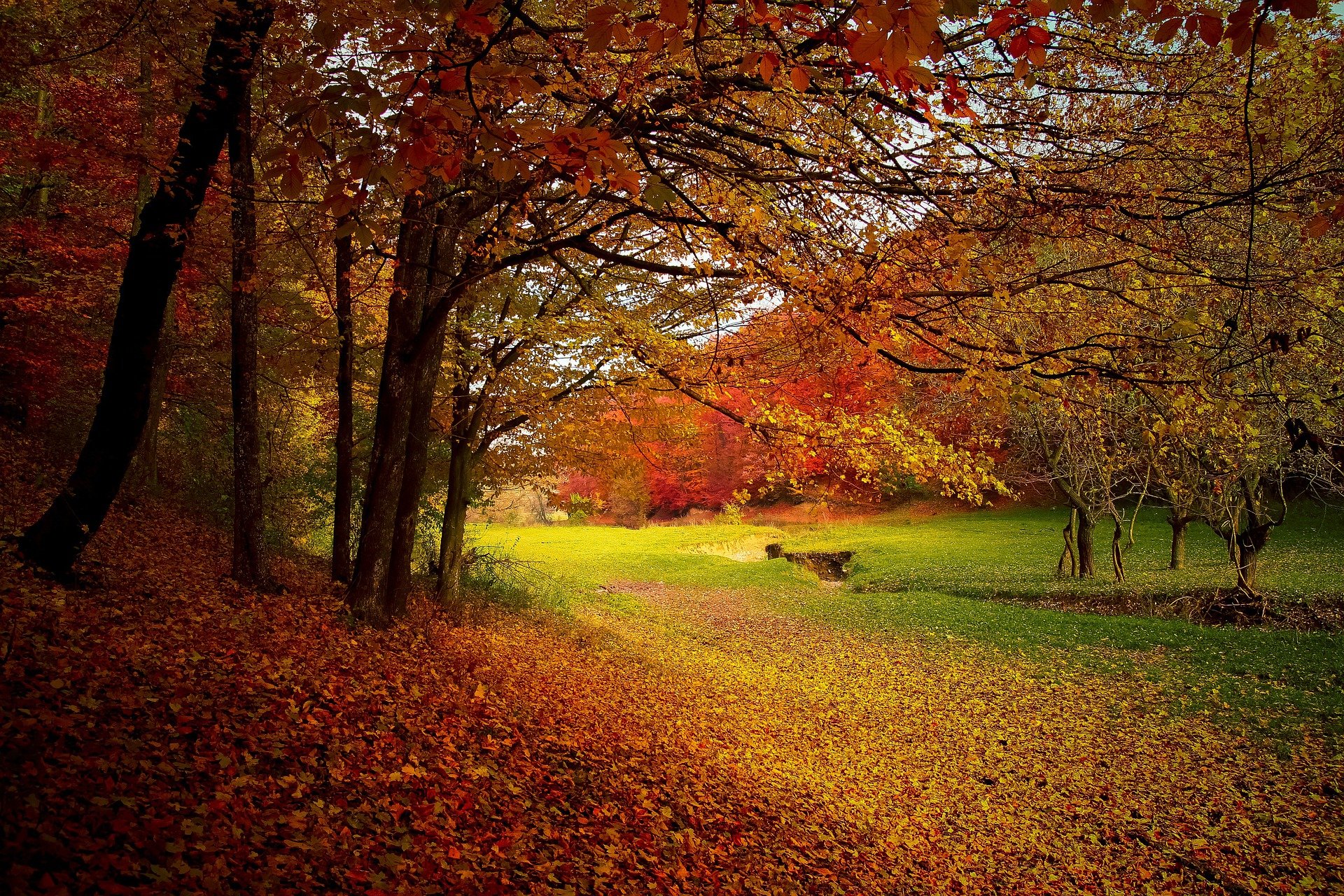Ancient and Contemporary Autumnal Traditions
Public domain image by Valentin via Pixabay
Written by Martha Kirby Capo
The Wheel rumble-tumbles, stumbles, then settles for a bit of a rest as the Earth tilts toward the beckoning cusp of Autumn. Autumn, with its crimsons and russets and golds, its rustles of licking, flicking not-quite-yet-chilling breezes snuffling through tall grasses, snaking across half-stalked fields plucked of their bounty. Festal Autumn, honored throughout centuries and civilizations to this day. How have different cultures celebrated this season?
Thesmophoria
In ancient Greece, the Thesmophoria was a three-day festival that served as a pre-harvest ritual. Held in late October*, the time when seeds for crops such as barley were sown, the celebration honored both human and agricultural fertility. The rites were honored by the Kore, a sisterhood of Demeter and Persephone, and attendance was restricted to the citizen-wives of Greece, who helped in organizing the Thesmophoria. Men could not participate in the rituals, and the details of the rituals were forbidden to them as well.
Thesmophoria rituals invoked divine protection for the land to ensure a bountiful harvest. Pigs were ritually sacrificed as part of the proceedings, and their remains were then mixed with the seeds prior to planting. The women made cakes shaped into snakes and phalluses, the crumbs of which were scattered on the fields before they were seeded. As a festival celebrating Demeter and Persephone, Thesmophoria also celebrated Persephone’s return from the Underworld.
* In Delos, Thebes, and other locations, the Thesmorphia was held in the summer as a harvest festival.
Mooncake Festival
The Mooncake Festival, also know as Zhong Qiu Jie in Mandarin, is a mid-autumn celebration that occurs on the 15th day of the eighth lunar month. As one might guess, the 15th day of a month is the middle of a month, and in China, the eighth lunar month is the middle of autumn. The festival has been celebrated for more than 2,000 years, very likely having its roots in the Song dynasty. It began as a post-harvest festival, and in ancient times was devoted to thanking the gods for the bounty that had been harvested. Traditionally, the day of the festival is thought to be lucky for weddings, with the moon goddess guaranteeing a happy marriage. The Mid-Autumn Festival is also a time for families to gather and spend time celebrating with each other.
The mooncakes associated with this festival have an interesting origin story, having to do with the overthrowing of the Mongol (Yuan) dynasty; the rebel leaders decided to coincide their rebellion with the Mid-Autumn Festival. They got permission from their Mongol oppressors to distribute mooncakes to the Chinese as a blessing to the longevity of the emperor. Inside each cake was a message: “kill the Mongols on the 15th day of the eighth month”. That was surely a Mid-Autumn Festival for the ages!
Homowo
The Ga people of Ghana celebrate Homowo as a remembrance of a great famine that happened in precolonial Ghana. The festival is also believed to have its roots in the Jewish feast of Passover. Homowo begins in August with the planting of yams and maize before the arrival of the rainy season. Later, the harvested maize is used in the foods prepared for the festival, and the food crumbs are sprinkled on the ground throughout the village. During Homowo, people parade through the streets while drumming and chanting. Traditional dances, face-painting, and singing are also part of the harvest festivities.
Diwali
The Diwali festival of lights is thought to be a fusion of harvest festivals that took place in ancient India. Diwali usually lasts 5 days sometime between mid-October and mid-November, and symbolizes the spiritual victories of light, good, and knowledge over their counterparts of darkness, evil, and ignorance. Written of in early Sanskrit texts, the celebration is associated with the goddess of prosperity, Lakshmi, and Ganesha, god of wisdom and remover of impediments.
Makali’i
The timing of the ancient Hawaiian festival of Makahiki is calculated by astronomical observations. “Makali’i” is the Hawaiian name for the Pleiades. When the Pleiades star cluster rises shortly after sunset, which generally happens around November 17, the rising of the following first crescent moon marks the end of harvest time. During Makali’i, the success of the harvest was celebrated with prayers and praise for the Creator, ancestral guardians, and caretakes of the elements.
Public domain image by StockSnap via Pixabay
Mabon
As you’ve read above, harvest celebrations have occurred throughout time and across the world. Pagans and Witches honor the harvest season on the autumnal equinox, which generally falls on or around September 21-23. Jason Mankey writes in his Witch’s Wheel of the Year that, while they were of course recognized, neither the Spring nor Fall Equinoxes were celebrated with specific holidays in ancient times. The term Mabon, in fact, was created by American Witch Aiden Kelly in 1974 (he also created the terms Litha and Ostara), and by 1979 the term had been reprinted so many times in so many publications that it had become canon and has been ever since (pp. 32-33).
In agrarian communities, after the long and busy seasons of planting, tending, and harvesting the summer and autumn crops, it’s no surprise that people would come together to share their thankfulness for having completed another growing season and to celebrate the fruits of their labors. Mabon is often known as the Witch’s Thanksgiving, and it’s not at all unusual to find Witches and Pagans gathered together feasting on autumnal delights such as squashes, apples, spinach, and radishes, whether they’re in rural or metropolitan areas.
Many Pagans and Witches also take time to consider what they have harvested spiritually from the intentions and personal goals they may have set months earlier during Imbolc. Mabon can be a time when you begin to take stock of the growth you’ve experienced over the past year as you prepare for Samhain, the Witch’s New Year.
If you’re searching for ways to celebrate the autumn harvest and the turning of the Wheel toward the quieter, slower seasons of introspection, take some cues from what’s happening around you locally. So many of us are no longer intimately connected to the agricultural rhythms of the land, but that doesn’t mean that there aren’t changes in our lives that are related to changes in the seasons. For instance, families with school-age children might think of creating autumnal traditions linked to those activities associated with the return to school. In fact, it’s very likely you already have some back-to-school traditions in place. Those who live in areas where the weather cools off quite a bit around Mabon might consider creating a small ritual around putting their summer clothes away to make room for their fall and winter gear in their closets.
Public domain image by Jill Wellington via Pixabay
In my current part of the United States, autumn marks the peak of hurricane season, so rituals around thunderstorms and tropical downpours authentically connect me to the change of season. A joke the local people make is that fall is when the palm fronds fall to the ground. Since palm fronds can weigh as much as 60 pounds (27 kilograms), you can be sure that many of us are keeping a weather eye on the trees around here as part of our autumn traditions!
Most crops can be grown in this area year-round, and the ones ready for harvest in autumn include squashes, cabbages, broccoli, and several greens. Apples, on the other hand, do not grow in this particular state. They’re available in the markets, but they are not produced locally - so even though they’re traditionally included in Mabon celebrations, they’re not currently part of my harvest rituals.
Whether you know it as Mabon, the Autumn Equinox, or Harvest Home, people all over the world have gathered together to celebrate the taking in of the crops, the sacrifices of the animals of the hunt and the nourishing gifts of their bodies, and the end of the summer season since time immemorial. These vast collected energies, repeated, rewoven, and ritualized through millennia, have coalesced into an almost Jungian thought-form that tugs at us even in these modern, machine-centric times. It half-whispers to us, “Autumn is coming, Autumn is coming,” and heed that call we must, for it is imprinted within us down to the very marrow of our bones. All is safely gathered in ere the winter storms begin and thus we raise the song of harvest home, as did our ancestors and their ancestors, and their ancestors before them, each joining in turn as the seasons circle ‘round once more.
May you and yours be blessed with abundance this Mabontide.
Martha Kirby Capo is a Solitary Witch currently working with Brigid, Hekate, Cernnunos, and Pan. She is the page manager of Patheos Pagan’s shared blog The Agora, where she writes as The Corner Crone. Martha's Moments for Meditation can be heard on KPPR Pure Pagan Radio and on her YouTube channel. She has been extensively anthologized through Skinner House books and has written for several magazines, including Witchology. Her book Thrifty Witchery, co-authored with Vincent Higginbotham, is available April 2023. You can follow her on Facebook and Instagram.
Sources
The Thesmophoria: Women's Ritual in the Ancient World by Christina Vakkas
Mid-autumn Festival (Zhong Qiu Jie) by Bonny Tan
The curious history of the mooncake by Staff Writers, chinatown.co.uk
About Homowo by Ghana Tourism Authority Staff Writers
Ancient Hawaiian celebration of Makahiki tied to the stars by Wayne Smith
Witch’s Wheel of the Year by Jason Mankey
Come, ye thankful people, come by Henry Alford




